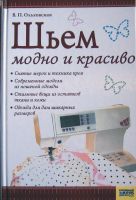Vera Olkhovskaya 2009 g
1. Fashion literature
Analyzing book production on fashion and tailoring, one can notice that the proposed methods for constructing patterns have some differences, which are visible in measurements, formulas and the style of presenting the material. According to the nature of the presentation, book methods of designing clothes can be conditionally divided into two categories: written by a cutter specializing in the field of individual tailoring and written by a clothing designer who develops patterns for large sewing enterprises.
The technique of the individualist cutter is usually elegant and simple. Few letter designations and transparent formulas, as well as an emphasis on the eye and common sense, make it easy to understand the logic of construction. The sequence of building a drawing is easy to remember.
The constructor's technique is described ponderously and is replete with letter designations, coefficients and indices. Two-story formulas make it difficult to include logic.
Unfortunately, clothing designers' books have dominated for about 50 years and are not associated with fashion in the reader. And what can dry textbooks with outdated models and “old-mode” processing methods be associated with? This phenomenon has led the fashion business to a paradox: professionals use ready-made patterns from magazines published for amateurs.
 From all of the above, another question arises: who benefits from writing and publishing outdated books on sewing? Answer: nobody. Modern authors of books on needlework are "narrow" professionals who do not know either the technique of drawing, or computer graphics necessary for constructing drawings, or the methodology for teaching cutting techniques. These people are just beginning to “creep out” the Internet, and they draw materials mainly from books published half a century ago. And the need to involve an artist and a computer graphics specialist reduces the already modest fees of the authors.
From all of the above, another question arises: who benefits from writing and publishing outdated books on sewing? Answer: nobody. Modern authors of books on needlework are "narrow" professionals who do not know either the technique of drawing, or computer graphics necessary for constructing drawings, or the methodology for teaching cutting techniques. These people are just beginning to “creep out” the Internet, and they draw materials mainly from books published half a century ago. And the need to involve an artist and a computer graphics specialist reduces the already modest fees of the authors.
It turns out that the future of applied literature remains with "broad" specialists who are able to combine several professions.
2. Professional tailors don't know how to cut?
Another paradoxical trend of our time. Why exactly? No, you cannot do without special skills, but it makes no sense to develop the basics (initial patterns) for modeling in the field of mass tailoring. You can just buy a magazine with ready-made patterns for all sizes, fortunately, the styles there are primitive, unmodel at will and put into production. This is how the cutters of many small sewing enterprises act. It is for them, and not for amateurs, that the unforgettable “Burda” works today, and that is why all people whose figure differs from the so-called “standard” still experience problems with clothing.
3. Needlework and computers.
Perhaps the most important step in the development of needlework and the clothing business over the past 20 years has been the beginning of the convergence of tailoring and computer technology. The computer-aided design of clothing patterns has already been mentioned.
The so-called "computer design system" works on any IBM-compatible computer under WINDOWS 98 and allows you to build patterns for any typical or individual figure. It is able to draw patterns in full size and in any scale, issuing a ready-made drawing on a printer or plotter, automatically generates seam allowances, and most importantly, achieves high quality patterns without releasing a sample.
 I note that the use of so-called "systems" for designing clothes, bypassing fashion magazines, that is, directly due to the high cost of software and technology, is still very limited even in garment factories, but there is already good news.
I note that the use of so-called "systems" for designing clothes, bypassing fashion magazines, that is, directly due to the high cost of software and technology, is still very limited even in garment factories, but there is already good news.
An example of this is the program according to the method of G. Zlachevskaya, which allows you to make bases and print them on a regular A4 printer. Disadvantages - you still have to model "manually".
Computerized sewing and embroidery machines look much more attractive to the consumer. Already there are industrial and household options. By connecting such a machine to a personal computer, you can download embroidery patterns into it. The software is updated via the Internet.
Interestingly, you can not only import embroidery patterns stored in the computer's memory into the machine, but also export the patterns of embroidery you have created to the computer for revision or storage. Patterns can be saved to USB devices and retrieved as needed. It is even possible to convert digital or scanned photographs into an embroidery design.
The price of such complexes is already approaching affordable, and the dimensions are suitable for small apartments and workshops. The spread of sewing and computer technology is still hindered by the fact that needlewomen, as a rule, do not know how to handle a computer.
Perhaps, in the near future, we will learn from the experience of European countries in opening free courses "eliminating sewing illiteracy" at sewing equipment stores. Bought a typewriter - you can go to courses. At the same time, the price of the same sewing and embroidery complex in the EU is about two times lower than in Ukraine.
4. Trends in the development of fashion business
 Like any business, fashion develops in many directions at once. The death of hand embroidery can already be considered inevitable, as the trend of automation and computerization of needlework is only gaining momentum.
Like any business, fashion develops in many directions at once. The death of hand embroidery can already be considered inevitable, as the trend of automation and computerization of needlework is only gaining momentum.
In support of the above, it is necessary to mention the so-called "fast fashion", which has already conquered 15% of developed countries and the capitals of the CIS. And in the outback has long been the main segment of the market.
From the name it is clear that everything is built on speed. If 20 years ago we, “homo sovieticus”, were talking about the “style of the 50s” or “style of the 70s”, which was determined by “trends” unchanged for several years, then already 15 years ago we were confronted with the fact of the existence of “mixed styles". And now, finally, today the usual two seasons are in the past - fashion designers are simply obliged to make at least four collections a year.
"Fast Fashion" has been hailed as a lifesaver for European clothing manufacturers as many wholesalers have stopped importing clothing from China and Asia.
Today, in order to speed up the process of creating fashionable clothes, European manufacturers send so-called “hunters” to high fashion shows, who, in between demonstrations of collections, fax a sketch to their company’s office.
It is worth noting that “fast fashion” is a “well-forgotten old” phenomenon and it is connected not so much with fashion itself, but with the next crisis in clothing production. To survive, a garment business owner must sew faster and sell more than before.
The industrial crisis of 1929-1933 gave rise to the first "fast fashion". It was during this period that the most industrious Parisian couturiers first began to show four collections a year.
Well, for us, all these difficulties are useless, since a person born in the post-Soviet space, especially a woman, has many talents. One of them is intuition, which will allow us to choose our own unique fashion style.


 Join my community on Viber...
Join my community on Viber...











